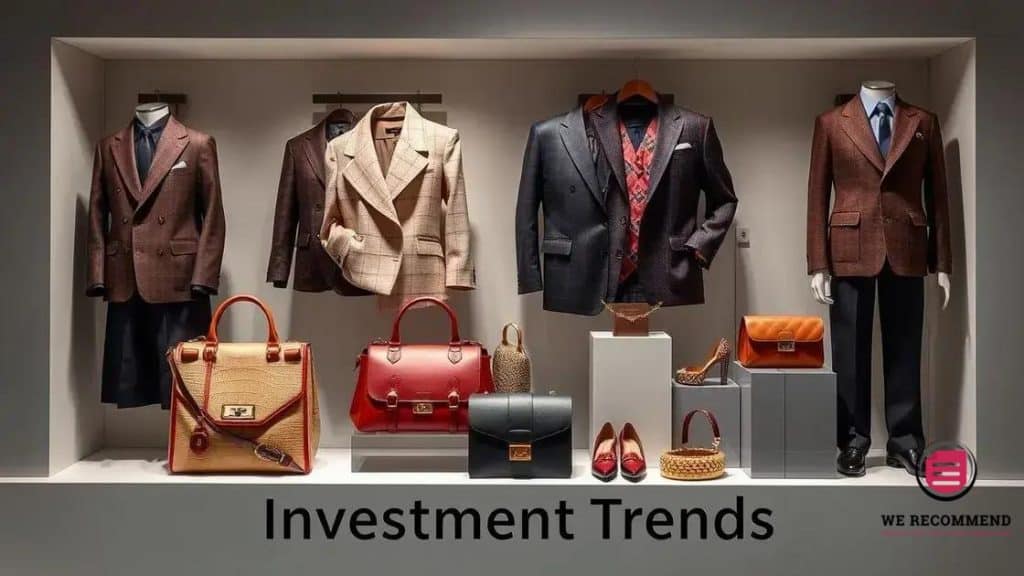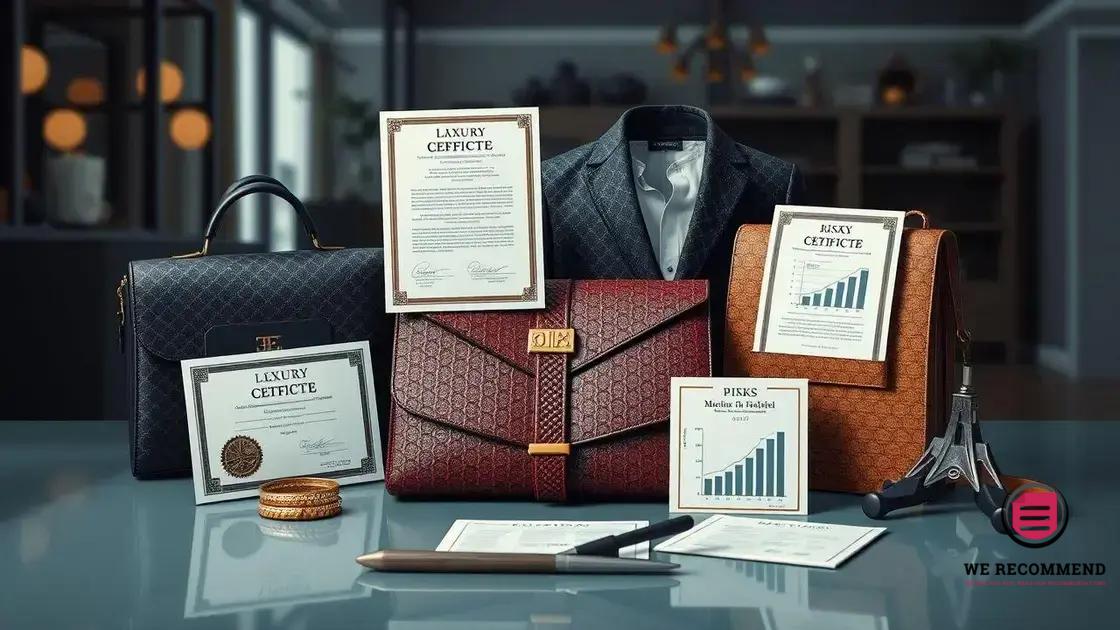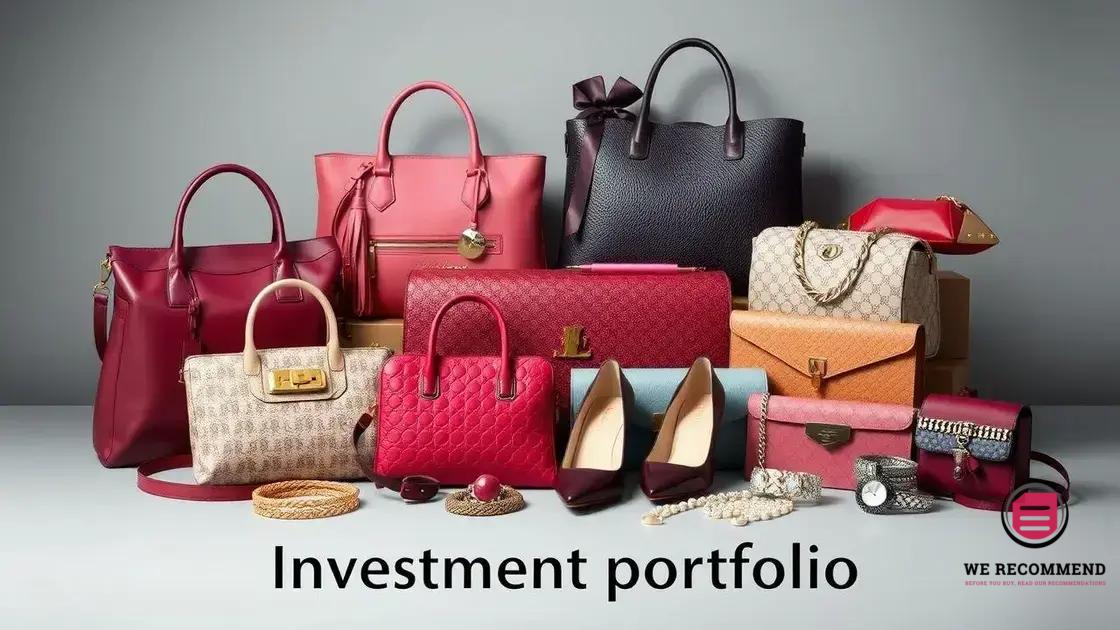Luxury fashion investments USA: what you need to know

Anúncios
Luxury fashion investments involve acquiring high-value items, with strategies focusing on authenticity, condition, and market trends to ensure profitable returns.
Luxury fashion investments USA offer more than just style; they can be a lucrative addition to your financial strategy. Have you thought about how designer pieces could contribute to your wealth? Let’s dive in and uncover the potential!
Anúncios
Understanding luxury fashion investments
Understanding luxury fashion investments is crucial for anyone looking to diversify their portfolio. These investments not only provide aesthetic pleasure but can also yield significant financial returns over time.
Anúncios
Investing in luxury fashion typically involves acquiring high-end items, such as designer clothing, handbags, and accessories. The value of these products can appreciate based on brand desirability, rarity, and condition.
Each luxury brand has its own unique market. For example, brands like Chanel, Louis Vuitton, and Gucci consistently show strong performance in the resale market.
Key Factors to Consider
- Brand Reputation: Brands with a strong heritage and reputation tend to retain value better.
- Condition: Items in pristine condition or with original packaging typically command higher prices.
- Market Trends: Keep an eye on the latest fashion trends, as they can influence demand for certain items.
For more in-depth insights, you can visit Business of Fashion.
Top brands worth investing in
When considering luxury fashion investments, it’s essential to identify the top brands that have a history of appreciation in value. Some brands stand out for their reliability and potential returns.
Investing in well-known brands can often lead to better long-term gains.
Brands like Hermès, Chanel, and Louis Vuitton are not only iconic but also maintain their desirability over time.
Key Investment Brands
- Hermès: Famous for its handcrafted bags, particularly the Birkin, which have consistently shown high return rates.
- Chanel: Timeless pieces, especially handbags and classic clothing, often appreciate significantly.
- Louis Vuitton: Their limited editions and collaborations create a strong resale market.
For more insights into high-end fashion investments, visit Town & Country.
Market trends and forecasts
Staying updated on market trends and forecasts in luxury fashion is essential for making informed investment decisions. The luxury fashion market has shown resilience and growth, despite economic challenges.
Recent trends highlight a shift towards sustainable fashion, with consumers increasingly valuing eco-friendly practices and ethical production. Brands that embrace these principles often perform better in the market.
Additionally, technology is playing a significant role in shaping the industry. Social media platforms and e-commerce are influencing purchasing behavior, leading to faster market changes.
Current Trends to Watch
- Rise of Pre-Owned Luxury: The resale market for luxury items is booming as buyers look for sustainable options.
- Digital Influence: Social media trends are dictating which items become popular, increasing the volatility of fashion investments.
- Focus on Sustainability: Brands that prioritize environmental responsibility are gaining traction and appeal among younger consumers.
For a deeper understanding of these trends, consider visiting Vogue’s website.
Risks associated with luxury fashion

Investing in luxury fashion comes with its own set of risks that potential investors should be aware of. While the allure of high-end products can be tempting, understanding these risks is crucial for making informed decisions.
One major risk is market volatility. Trends in the fashion industry can change rapidly, which may lead to sudden drops in the value of luxury items.
Additionally, there is the risk of counterfeit products. The luxury fashion market has long been plagued by fakes, making it essential to verify authenticity before purchasing.
Types of Risks to Consider
- Depreciation: Some items may lose their value faster than anticipated, especially if they are not part of a classic collection.
- Market Trends: Changing consumer preferences can lead to items that were once highly sought after becoming less desirable.
- Storage and Maintenance: Luxury items require proper care; neglecting this can affect their condition and resale value.
To dive deeper into understanding these risks, visit Forbes.
Tips for starting your investment journey
Starting your investment journey in luxury fashion can be exciting but also challenging. To guide you, here are some essential tips that can help set you on the right path.
First, research is key. Understand the brands, their histories, and current market demand. Knowing what is popular and why can help you make informed choices.
Another important aspect is to define your budget. Set a limit on how much you are willing to invest. This will help you avoid overspending and keep your focus.
Important Tips for New Investors
- Start Small: Begin with one or two items that interest you. This allows you to learn without overwhelming yourself.
- Stay Informed: Follow fashion news and reports to keep up with trends and changes in the market.
- Join Communities: Connect with other investors or collectors. They can provide valuable insights and advice.
For detailed guidance on fashion investments, consider visiting Business of Fashion.
How to evaluate luxury fashion items
Evaluating luxury fashion items is an important step for investors and collectors. Proper evaluation ensures that you make wise purchases that hold their value over time.
The first aspect to consider is authenticity. Always check for original tags, logos, and serial numbers. Familiarizing yourself with how different brands mark their items can help you avoid counterfeits.
Another factor is the condition of the item. Look for signs of wear, tear, or damage. Items in pristine condition are typically worth more.
Key Evaluation Criteria
- Brand Reputation: Research the brand’s history and market standing. High-demand brands generally retain value better.
- Market Trends: Stay informed about current market demand for specific items to gauge their investment potential.
- Resale Value: Check recent sales data for similar items to understand potential returns on your investment.
For further insights on evaluating luxury fashion, visit Highsnobiety.
The role of auctions in luxury investments
Auctions play a significant role in luxury investments, offering buyers unique opportunities to acquire rare and valuable items. These events can attract both seasoned collectors and new investors looking to enter the market.
Participating in auctions often gives access to one-of-a-kind pieces that are not available in traditional retail settings. The competitive nature of bidding can also drive prices up, reflecting the true value of coveted items.
Understanding the auction process is key to making successful investments. Research the auction house and the items going up for bid to make informed decisions.
Benefits of Auctions
- Diverse Selection: Auctions provide a wide variety of luxury items, from handbags to rare watches.
- Market Insights: Auction results can give valuable information about current market trends and item valuations.
- Networking Opportunities: Attending auctions allows investors to meet other collectors and industry experts, enhancing their understanding of the market.
For more insights on the role of auctions, consider checking out Sotheby’s.
Building a diversified investment portfolio

Building a diversified investment portfolio is essential for managing risk in luxury fashion investments. A well-rounded portfolio can help you navigate market fluctuations and protect your assets.
Investors should consider including a variety of categories in their portfolios, such as handbags, apparel, jewelry, and footwear. Each category may perform differently under various market conditions.
It’s also wise to invest in a mix of established brands and emerging labels. This approach allows you to benefit from both stable investment returns and potential growth opportunities.
Key Strategies for Diversification
- Mix Categories: Include different types of luxury items to balance your investment.
- Invest in Multiple Brands: Diversifying across various reputable brands reduces reliance on a single label.
- Monitor Market Trends: Stay updated to adjust your portfolio and capitalize on emerging opportunities.
For more insights on building a diversified investment strategy, consider visiting Investopedia.
In summary: The potential of luxury fashion investments
Investing in luxury fashion can be exciting and rewarding. By understanding the market trends, evaluating items carefully, and building a diversified portfolio, you can maximize your chances of success.
Remember to stay informed and connect with other investors to enhance your knowledge. Auctions can offer unique opportunities to find rare pieces, while being aware of risks will help you make better decisions.
Overall, with the right strategies and insights, luxury fashion investments can be a valuable addition to your financial portfolio.
FAQ – Frequently Asked Questions About Luxury Fashion Investments
What are the main benefits of investing in luxury fashion?
Investing in luxury fashion can provide significant returns, access to unique items, and the enjoyment of owning high-quality products.
How do I determine the authenticity of a luxury item?
Check for original tags, logos, serial numbers, and consider consulting experts or reputable sources to verify authenticity.
What should I include in a diversified luxury fashion portfolio?
Include a mix of different categories such as handbags, clothing, and accessories from various renowned brands to spread risk.
Why are auctions important for luxury investments?
Auctions offer access to rare items and can provide insights into current market trends and values through the competitive bidding process.






